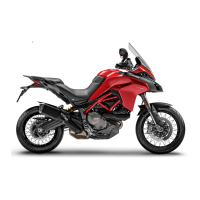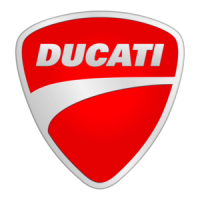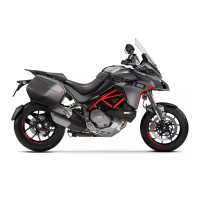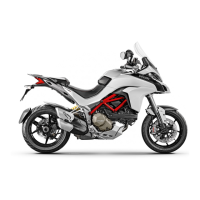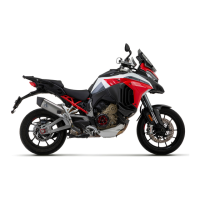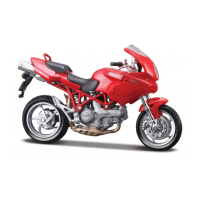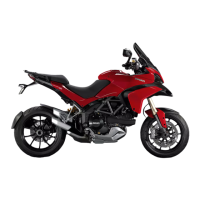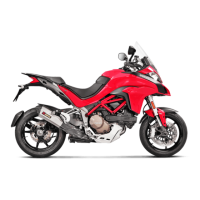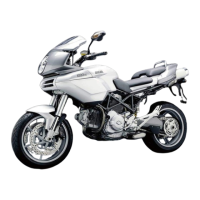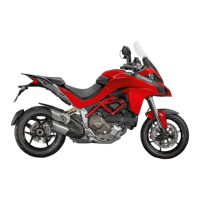Do you have a question about the Ducati MULTISTRADA 950 and is the answer not in the manual?
General safety rules and precautions for riding the motorcycle.
Specifies the designed usage conditions and limitations of the motorcycle.
Outlines legal and safety responsibilities for motorcycle riders.
Emphasizes the importance of rider skill and training for safe operation.
Details essential protective clothing and gear for safe riding.
Key safety procedures and checks to perform before, during, and after riding.
Instructions on how and where to refuel the motorcycle safely and correctly.
Guidelines on weight limits and distribution for safe carrying of luggage.
Overview of the motorcycle's instrument panel and its functions.
Detailed description of each indicator light and display element on the instrument panel.
Lists and explains the information shown on the motorcycle's main display screen.
Details the primary and secondary functions accessible through the instrument panel menus.
Description of the four available riding modes and their customization options.
Step-by-step guide on how to change the motorcycle's riding mode.
Explanation of the Anti-lock Braking System and its status indication.
Detailed explanation of how the ABS system works, including combined braking and cornering functions.
Explanation of the Ducati Traction Control system and its status display.
Details the Ducati Quick Shift (DQS) system, its function, and usage tips.
Lists and describes the functions accessible through the instrument panel's menu system.
How average fuel consumption is calculated, displayed, and reset.
Explains the display of real-time fuel consumption and its calculation basis.
How average speed is calculated, displayed, and reset.
Management of the audio player function via Bluetooth and smartphone connection.
How to view and manage incoming, outgoing, and missed calls via Bluetooth.
Procedure for enabling or disabling the ABS system, restricted to Enduro mode.
Accessing and navigating the main settings menu for motorcycle functions.
How to customize parameters for each of the four available riding modes.
Adjusting engine power delivery (HIGH, MEDIUM, LOW) for each riding mode.
Setting the Ducati Traction Control (DTC) intervention level for each riding mode.
Adjusting the Anti-lock Braking System (ABS) level for each riding mode.
Enabling or disabling the Ducati Quick Shift (DQS) feature based on riding mode.
Instructions for activating and setting a personal identification number (PIN) for security.
Step-by-step process to activate the PIN CODE function and set a new PIN.
Procedure for changing an existing PIN CODE and setting a new one.
Information on service deadlines for Oil, Desmo, and Annual services.
Managing Bluetooth device pairing and deletion for connectivity.
Steps for pairing Bluetooth devices like smartphones, helmets, and GPS navigators.
Configuring automatic turn signal deactivation based on riding conditions.
Overview of the Ducati Multimedia System (DMS) for audio, calls, and notifications.
Managing phone calls, missed calls, and call history via the Bluetooth system.
Controlling the audio player for music playback via smartphone connection.
Explanation of the VHC system for holding the vehicle at a standstill.
Indicates when the motorcycle is due for service at an authorized center.
How the instrument panel indicates engine or general system errors.
Operation of headlights, including switching between low and high beams.
Manual and automatic control of turn signals, including deactivation features.
Explanation of the electronic engine block system for anti-theft protection.
Information about the motorcycle keys and their immobilizer system code.
Procedure to temporarily restore operation using the PIN code in case of key issues.
Steps to enter the override PIN code to restore motorcycle operation.
Identifies the location and function of key controls like levers, pedals, and switches.
Operation of the ignition switch, steering lock, and key positions.
Functionality of the left-hand handlebar switchgear, including lights and turn signals.
Guidelines for the initial running-in period to ensure optimal engine and component performance.
Essential checks to perform before riding to ensure safety and proper operation.
Procedure for starting and stopping the motorcycle's engine safely.
Step-by-step guide on how to start moving the motorcycle from a standstill.
Techniques for effective braking, including ABS operation and recommendations.
Instructions for removing and charging the motorcycle battery safely.
Table detailing maintenance tasks and intervals performed by authorized dealers.
Table outlining routine maintenance tasks recommended for the customer to perform.
Technical specifications of the Ducati Testastretta engine, including bore, stroke, and power.
Description of the front and rear braking systems, including ABS and calliper details.
General safety rules and precautions for riding the motorcycle.
Specifies the designed usage conditions and limitations of the motorcycle.
Outlines legal and safety responsibilities for motorcycle riders.
Emphasizes the importance of rider skill and training for safe operation.
Details essential protective clothing and gear for safe riding.
Key safety procedures and checks to perform before, during, and after riding.
Instructions on how and where to refuel the motorcycle safely and correctly.
Guidelines on weight limits and distribution for safe carrying of luggage.
Overview of the motorcycle's instrument panel and its functions.
Detailed description of each indicator light and display element on the instrument panel.
Lists and explains the information shown on the motorcycle's main display screen.
Details the primary and secondary functions accessible through the instrument panel menus.
Description of the four available riding modes and their customization options.
Step-by-step guide on how to change the motorcycle's riding mode.
Explanation of the Anti-lock Braking System and its status indication.
Detailed explanation of how the ABS system works, including combined braking and cornering functions.
Explanation of the Ducati Traction Control system and its status display.
Details the Ducati Quick Shift (DQS) system, its function, and usage tips.
Lists and describes the functions accessible through the instrument panel's menu system.
How average fuel consumption is calculated, displayed, and reset.
Explains the display of real-time fuel consumption and its calculation basis.
How average speed is calculated, displayed, and reset.
Management of the audio player function via Bluetooth and smartphone connection.
How to view and manage incoming, outgoing, and missed calls via Bluetooth.
Procedure for enabling or disabling the ABS system, restricted to Enduro mode.
Accessing and navigating the main settings menu for motorcycle functions.
How to customize parameters for each of the four available riding modes.
Adjusting engine power delivery (HIGH, MEDIUM, LOW) for each riding mode.
Setting the Ducati Traction Control (DTC) intervention level for each riding mode.
Adjusting the Anti-lock Braking System (ABS) level for each riding mode.
Enabling or disabling the Ducati Quick Shift (DQS) feature based on riding mode.
Instructions for activating and setting a personal identification number (PIN) for security.
Step-by-step process to activate the PIN CODE function and set a new PIN.
Procedure for changing an existing PIN CODE and setting a new one.
Information on service deadlines for Oil, Desmo, and Annual services.
Managing Bluetooth device pairing and deletion for connectivity.
Steps for pairing Bluetooth devices like smartphones, helmets, and GPS navigators.
Configuring automatic turn signal deactivation based on riding conditions.
Overview of the Ducati Multimedia System (DMS) for audio, calls, and notifications.
Managing phone calls, missed calls, and call history via the Bluetooth system.
Controlling the audio player for music playback via smartphone connection.
Explanation of the VHC system for holding the vehicle at a standstill.
Indicates when the motorcycle is due for service at an authorized center.
How the instrument panel indicates engine or general system errors.
Operation of headlights, including switching between low and high beams.
Manual and automatic control of turn signals, including deactivation features.
Explanation of the electronic engine block system for anti-theft protection.
Information about the motorcycle keys and their immobilizer system code.
Procedure to temporarily restore operation using the PIN code in case of key issues.
Steps to enter the override PIN code to restore motorcycle operation.
Identifies the location and function of key controls like levers, pedals, and switches.
Operation of the ignition switch, steering lock, and key positions.
Functionality of the left-hand handlebar switchgear, including lights and turn signals.
Guidelines for the initial running-in period to ensure optimal engine and component performance.
Essential checks to perform before riding to ensure safety and proper operation.
Procedure for starting and stopping the motorcycle's engine safely.
Step-by-step guide on how to start moving the motorcycle from a standstill.
Techniques for effective braking, including ABS operation and recommendations.
Instructions for removing and charging the motorcycle battery safely.
Table detailing maintenance tasks and intervals performed by authorized dealers.
Table outlining routine maintenance tasks recommended for the customer to perform.
Technical specifications of the Ducati Testastretta engine, including bore, stroke, and power.
Description of the front and rear braking systems, including ABS and calliper details.
| Power | 113 hp (83 kW) @ 9, 000 rpm |
|---|---|
| Torque | 96 Nm (71 lb-ft) @ 7, 750 rpm |
| Transmission | 6-speed |
| Frame | Tubular steel trellis frame |
| Seat Height | 840 mm (33.1 in) |
| Dry Weight | 204 kg (450 lb) |
| Wheelbase | 1, 594 mm (62.8 in) |
| Tires Front | 120/70 ZR19 |
| Tires Rear | 170/60 ZR17 |
| Engine Type | L-twin, 4 valves per cylinder, Desmodromic, liquid cooled |
| Fuel System | Electronic fuel injection, 53 mm throttle bodies |
| Front Suspension | 48 mm fully adjustable usd fork |
| Rear Suspension | Fully adjustable monoshock |
| Front Brake | 2 x 320 mm semi-floating discs, radially mounted Brembo monobloc 4-piston calipers |
| Rear Brake | 265 mm disc, 2-piston floating caliper |
| Fuel Tank Capacity | 20 l (5.3 US gal) |
